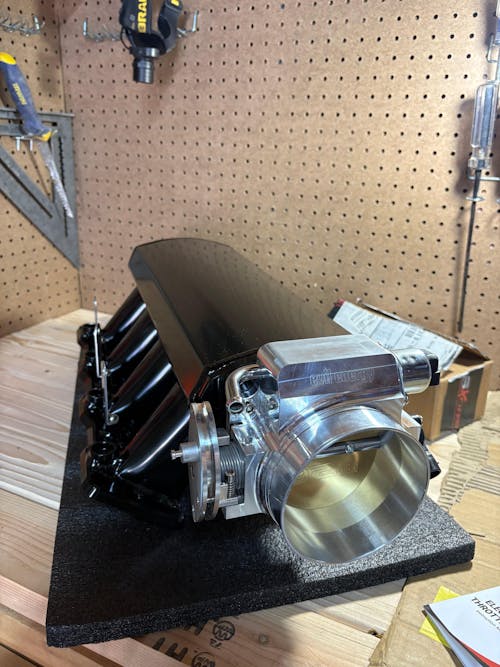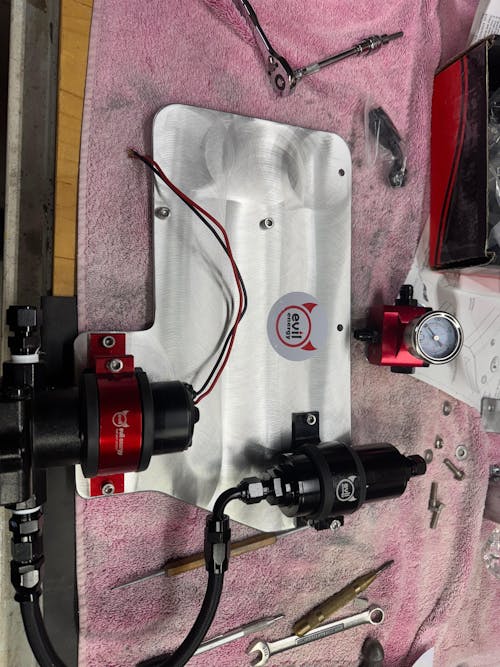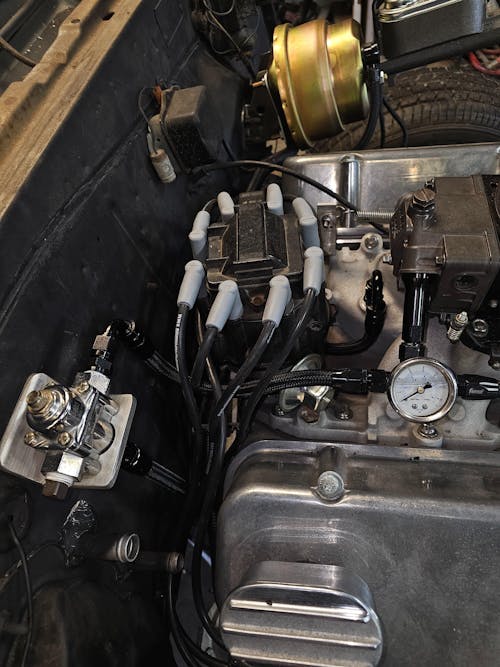How to Choose the Best Cold Air Intake for Your Toyota Tacoma
Are you searching for the best cold air intake for the Toyota Tacoma? Whether you want to improve daily throttle response or prep for off-roading, upgrading the factory intake is one of the most effective mods. A well-designed cold air intake for Toyota Tacoma removes factory air restrictions, which can increase horsepower, torque, and throttle response, all while delivering a much better engine sound.
For a 2016-2023 Toyota Tacoma 3.5L, a cold air intake is a great upgrade because it typically does not require an ECU tune. Of course, if you decide to add a tune later, you will maximize the full performance potential of the hardware. But with so many options—metal, plastic, open, closed—how do you choose the right cold air intake for your Toyota Tacoma?
We'll break down the selection process into three key categories: Construction Material, Airbox Design, and Filter Type.

Construction Material: Metal vs. Plastic
When choosing a cold air intake for the Toyota Tacoma, the material of the intake tube and airbox affects temperature management and cost.

- Plastic (High-Density Polyethylene):
-
Pros: Plastic is now the mainstream choice. It's lightweight, and roto-molding allows for complex, smooth internal passages for optimized design. Its biggest advantage is resisting heat soak. It dissipates heat much faster than metal at low speeds or at a red light, helping to maintain lower intake air temperatures (IAT).
-
Cons: May not have the premium polished look of metal.
- Metal (Usually Aluminum):
-
Pros: A cold air intake for the Toyota Tacoma made of aluminum often features mandrel-bent tubing, ensuring no kinks or narrow spots in the bends for the smoothest possible airflow. Aluminum is very strong, highly heat-resistant, and can be polished or painted for a premium look.
-
Cons: Metal conducts and holds heat more effectively. While it takes longer to heat up, once it's soaked with engine bay heat in traffic, it also takes longer to cool back down.
Airbox Design: Open vs. Closed (The Key Choice)
The airbox design is the heart of the system. This is the key factor in determining if you have the best cold air intake for your Toyota Tacoma for your needs. It dictates whether the filter breathes cool air or hot engine bay air and how much protection it gets.

- Open Airbox:
-
Pros: This design is often more cost-effective, acting more like a 'heat shield' than a fully sealed box. It exposes the filter, allowing it to draw in more air and creating the loudest intake sound.
-
Cons: Not recommended for heavy off-roading. On dusty or muddy trails, debris and water can easily enter the filter, causing it to clog or fail prematurely.
-
Best For: Trucks used primarily on paved roads that are seeking aggressive sound and value.
- Closed Airbox:
-
Pros: This is the design for optimal performance and protection. It completely seals the filter inside a box and uses ducting to draw fresh air directly from the cooler fender well or grille area. For a 2016-2023 Toyota Tacoma 3.5L, a cold air intake with a closed box is the most reliable choice if you off-road frequently, as it most effectively isolates the filter from engine heat and debris.
-
Cons: Typically more expensive due to the complex design and extra materials.
-
Best For: Trucks that frequently go off-road, ford water, or drive in dusty, harsh environments.
Filter Type: Oiled vs. Dry
The filter is the first line of defense for your engine.
-
Oiled Filters:
-
Pros: The filter media is coated in a special oil, making it sticky to trap very fine dust particles. They are washable and reusable, which can be economical long term.
-
Cons: Requires regular maintenance (washing and re-oiling). If you over-oil the filter, the excess can contaminate the Mass Air Flow (MAF) sensor. They can get 'caked' with dust more quickly in off-road environments.
-
Dry Filters:
-
Pros: These filters do not use oil, relying on multi-layer synthetic media to filter particles. They are also washable and reusable, but maintenance is simpler. Dry filters are a top choice for many cold air intakes for Toyota Tacoma models because they are 100% MAF-safe and ideal for off-road use.
-
Cons: No significant downsides; they are the modern, popular choice.

In-Depth Review: EVIL ENERGY Cold Air Intake (2016–2023 Tacoma 3.5L)
Based on the criteria above, the EVIL ENERGY Cold Air Intake is an excellent, well-balanced choice. It features a durable heat shield design (addressing heat soak) and a high-flow dry filter (making it MAF-safe and off-road friendly).
This Toyota Tacoma 3.5L cold air intake (2016–2023) delivers crisper throttle response, steadier intake air temps (IAT) in heat and traffic, and a deeper intake note without highway drone. Typical DIY install time is 45–90 minutes with hand tools. In CARB states, choose the CARB-EO version to stay street-legal.
Buy Now → EVIL ENERGY Cold Air Intake — 2016–2023 Tacoma 3.5L

Why upgrade the Toyota Tacoma 3.5L cold air intake?
The Gen-3 Tacoma’s 2GR-FKS(Engine) uses Toyota’s D-4S dual-injection system; the factory airbox is quiet and conservative. A well-designed CAI, like this EVIL ENERGY Cold Air Intake, improves tip-in and mid-range pull, especially with all-terrain tires, armor, racks, or towing.
You’ll feel:
-
Quicker throttle around town and on-ramp merges
-
Cooler, more consistent IAT thanks to heat shielding & ducting (less heat-soak)
-
Richer intake sound under load with calm cruise manners
-
Lower lifetime cost via a dry, reusable filter (no oiling, MAF-friendly)
-
Exact fitment (no guesswork)
Fitment & Compliance
-
Model years: 2016, 2017, 2018, 2019, 2020, 2021, 2022, 2023
-
Engine: 3.5L V6 2GR-FKS (D-4S) only
-
Trims: SR, SR5, TRD Sport, TRD Off-Road, Limited, TRD Pro*
-
Notes: TRD Pro snorkel/secondary equipment or dual-battery setups—check space and hose routing
-
TRD snorkel owners: verify duct interface and sealing strategy.
-
Compliance: If you live in California/CARB states, select the CARB Executive Order (EO) variant for emissions-legal street use.
EVIL ENERGY Cold Air Intake vs. Stock Tacoma 3.5L Airbox
Most 3.5L owners report the biggest wins in response and temperature stability; peak hp varies by conditions (real-world +5–12 hp typical, not guaranteed).
| Dimension | Stock Airbox | EVIL ENERGY CAI (2016–2023 3.5L) |
| Throttle feel | Gentle, laggy with load | Crisper, stronger mid-range |
| IAT/heat-soak | Rises quickly in traffic & summer | Shielded/ducted path tempers IAT |
| Sound | Very quiet | Deeper under throttle, quiet at cruise |
| Upkeep | Paper element | Dry, reusable filter; no oiling |
| CEL risk | Low | Low when MAF is clocked correctly & joints sealed |
| Legality (CARB) | OEM legal | Choose CARB-EO version in CARB states |
EVIL ENERGY EVIL ENERGY Cold Air Intake highlights
-
Dry high-flow filter — easy cleaning, dust-friendly, MAF-safe
-
Airbox/heat shield + ducting — helps reduce heat-soak on climbs, trails, and in traffic
-
Correct MAF boss geometry — supports stable trims; avoids CELs when installed properly
-
No-cut, reversible install — hand tools only; back to stock anytime
-
Trail-serviceable design — quick filter access; robust brackets & isolation
Add to cart → EVIL ENERGY Cold Air Intake — Tacoma 3.5L (2016–2023)

EVIL ENERGY Cold Air Intake DIY Install Guide
Tools: 10/12/13 mm sockets, screwdrivers, pliers, torque wrench (recommended), clean rag
Pro tips: Seat every coupler fully, clock the MAF sensor exactly like stock, and allow time for ECU adaptation.
-
Remove the engine cover and the factory airbox/tube.
-
Unplug the MAF sensor and mark its OE orientation.
-
Install heat shield/airbox and brackets; verify wiring/hoses clear.
-
Fit intake tube & filter; align, seat couplers, and lightly snug clamps.
-
Reinstall MAF in the same clocking/arrow direction; tighten to spec.
-
Torque clamps; confirm no contact with hot or moving parts.
-
Start the truck; check the idle and any warning lights. Road test 10–15 minutes.
-
Let the ECU adapt over 50–100 miles (or do a battery reset if desired).
Common mistakes & quick fixes
-
Small air leak = big annoyance → Re-torque clamps, re-seat couplers
-
Wrong MAF angle → Rotate to match OE mark; clear trims if needed
-
Filter too close to heat → Reposition shield/ducting for clearance
Maintenance & ownership costs
-
Highway/city: clean every 10–15k miles
-
Dusty trails/desert: clean every 5–8k miles; consider a pre-filter
-
At each oil change, inspect clamps, seals, and rubber isolators.
-
Dry, reusable filters reduce ongoing costs vs. buying paper elements repeatedly.

Off-road, water & towing notes (for Gen-3 owners)
-
A CAI is not a snorkel—slow down in deep water and splash sections.
-
Summer towing or long grades: monitor temps; the shielded path helps IAT, but physics still apply—cool-down when needed.
-
Dust days: shorten cleaning intervals; verify lid/edge gaskets and box sealing.
FAQs (2016–2023 Tacoma 3.5L)
Will it improve MPG? Some owners see +0–1 MPG on steady cruise. The bigger win for this cold air intake for the Toyota Tacoma is quicker response and mid-range driveability.
Will it cause a check-engine light? With proper sealing and correct MAF clocking, typically no. If a CEL appears, check for leaks and MAF angle first.
Do I need a tune on the 2GR-FKS? Not required. This 2016-2023 Toyota Tacoma 3.5L cold air intake is designed to work with the stock ECU. Tunes can refine airflow if you also upgrade the exhaust/intercooler or re-gear for bigger tires.
Is this legal in California? Choose the CARB-EO version for emissions-legal street use. Non-EO kits are generally 'race/off-road only' in CARB states.
Does it drone on the highway? No—expect a richer intake note under throttle with calm cruise manners.
60-Second Buy Checklist
✅ 2016–2023 Tacoma 3.5L-specific fit (2GR-FKS, D-4S)
✅ Noticeable throttle response and smoother mid-range
✅ Shielded/ducted path to temper IAT/heat-soak
✅ Dry, reusable filter lowers lifetime costs
✅ 45–90 min DIY install, reversible
✅ CARB-EO option available/recommended for CARB states
This is the best cold air intake for Toyota Tacoma owner who wants a simple, effective, and safe upgrade.
Get yours → EVIL ENERGY Cold Air Intake — 2016–2023 Toyota Tacoma 3.5L




![[20FT] EVIL ENERGY PTFE Fuel Line Kit, complete black hose & fittings set, 180-day return](http://www.ievilenergy.com/cdn/shop/files/Test-2025-Evilenergy-125598065_165x.png?v=1742144807)
![[16FT] EVIL ENERGY PTFE Fuel Line Kit, black braided hose, fittings, free shipping & return](http://www.ievilenergy.com/cdn/shop/files/Test-2025-Evilenergy-125598171_165x.png?v=1742144807)
![CPE Fuel Line[25FT]](http://www.ievilenergy.com/cdn/shop/files/25FTCPE_FuelLine_165x.png?v=1735220649)
![CPE Fuel Line[20FT]](http://www.ievilenergy.com/cdn/shop/files/20FTCPE_FuelLine_165x.png?v=1735220649)















